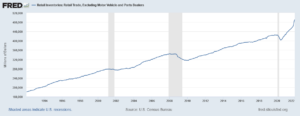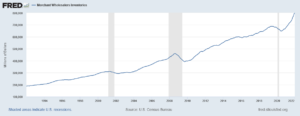March 30, 2022
We have heard much about the supply chain crisis as we recover from the pandemic recession. As the economy has bounced back there have been shortages of many items with the economy unable to produce and ship the volume of goods that is being demanded. Many of us see this supply chain crisis as the main factor behind the upsurge in inflation that we have witnessed over the last year.
My expectation has been that the many items that have soared in price over the last year will see prices stabilize and fall when the supply chain crunch eases. I have repeatedly used the case of televisions as an example. Television prices had been on a downward path for decades, but the CPI index for televisions rose 8.7 percent between March and August of last year. The index then turned around, and has since dropped by 6.3 percent, reversing most of the prior increase.
Used cars provide another example. Used car prices soared in 2020 and 2021, with the index rising by more than 50 percent between February 2020 and January 2022. However, prices began falling in February. In one private price index, by the middle of March, used car prices had fallen almost 6.0 percent from their January peak.
If we see a comparable price decline in other items that have had extraordinary runups in prices in the last year, like appliances, clothing, and household furnishing, it will sharply dampen the inflation rate going forward. The key factor in this story is resolving the supply chain crisis.
This is where inventories come in. Inventories fell sharply in 2020, as many businesses sharply cut back production or shutdown altogether at the start of the pandemic. Inventories did begin to increase later in the year, but not as fast as consumption. Large parts of the service sector remained shut, so people shifted their consumption from areas like restaurants and travel, to cars, televisions, and appliances.
But, demand is now shifting back the other way. People are going to restaurants at pretty much the same rate as before the pandemic. While air travel is still somewhat below the pre-pandemic pace, most of the remaining gap is likely explained by reduced business travel. (I had a number of flights last week and they were all packed.)
Anyhow, this shift to services means that people must either be cutting back on their demand for goods, or spending a larger share of their income, and thereby saving less. Thus far in the recovery, the saving rate has remained relatively high, even as the pandemic payments and unemployment insurance supplements fade into the past.
It’s possible that this will change going forward, as people spend out of the savings they accumulated during the pandemic. However, it’s also possible that they will pay for their increased demand for services, by reducing their demand for goods.
In this story, it is worth noting that overall consumption is not especially high right now. Overall consumption in January, the last month for which we have data, was 5.0 percent higher, after adjusting for inflation, than in the fourth quarter of 2019. This implies a 2.3 percent annual rate of growth, pretty much in line with longer term trends.
While overall consumption is not out of line with its longer-term trend, demand for goods is. Durable goods consumption was 25.7 percent higher in January than in the fourth quarter of 2019 and consumption of non-durables was 13.0 percent higher, implying respective annual growth rates of 10.9 percent and 5.7 percent. If consumption of goods falls back closer to its trend growth path, then we will see an inventory glut.
Here’s the picture for retail non-car inventories.[1]

As can be seen, there has been there has been a sharp rise in recent months, with the level in January standing 16.1 percent above the February 2020 level. We saw a further 1.2 percent rise in non-car inventories in February, putting them 17.4 percent above their pre-pandemic level. The cumulative inflation in non-car goods over this period has been 12.1 percent (much of this is higher gasoline prices), which means that if consumption of goods fell back to its trend level, we would be back to pre-pandemic inventory-to-sales ratios and the supply chain crisis would be largely behind us.
The picture looks even better at the wholesale level.

These data (which include inventories of vehicles) have risen even more sharply in recent months. If we include the 2.1 percent jump in February, wholesale inventories were 20.8 percent above their pre-pandemic level. And, wholesale inventories usually end up as retail inventories in the not distant future.
These data suggest that in many categories of goods, we should have a very adequate supply in the not distant future. This will be especially true if we see consumption of goods and services revert to more normal patterns.
In this respect it is worth noting that large bursts of goods consumption tend to be followed by lower consumption in future periods. If people buy a new car or refrigerator in 2021, they are not likely to buy another car or refrigerator in 2022 or 2023. The huge burst of goods consumption that we saw in 2020 and 2021 should be another factor, in addition to the winding down of the pandemic, leading to a shift to services.
In short, the inventory data indicate that we should be getting to the end of shortages due to supply chain problems. This doesn’t mean that there will not still be many items, most notably new cars, that are in short supply, but these will be the exception rather than the rule. In that story, we will likely see price declines in a wide range of items, pulling down inflation in the rest of 2022.
[1] The supply of cars has been limited by a worldwide shortage of semi-conductors due to a fire in a large semi-conductor factory in Japan. This is a separate issue from more general supply chain problems.







Comments